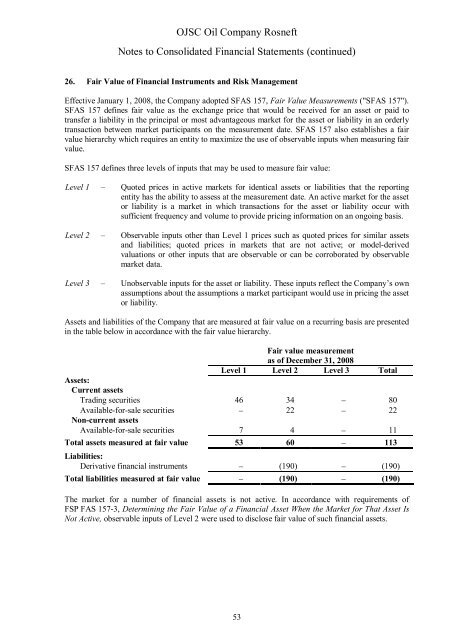OJSC Oil Company Rosneft Consolidated Financial Statements
OJSC Oil Company Rosneft Consolidated Financial Statements
OJSC Oil Company Rosneft Consolidated Financial Statements
Create successful ePaper yourself
Turn your PDF publications into a flip-book with our unique Google optimized e-Paper software.
<strong>OJSC</strong> <strong>Oil</strong> <strong>Company</strong> <strong>Rosneft</strong><br />
Notes to <strong>Consolidated</strong> <strong>Financial</strong> <strong>Statements</strong> (continued)<br />
26. Fair Value of <strong>Financial</strong> Instruments and Risk Management<br />
Effective January 1, 2008, the <strong>Company</strong> adopted SFAS 157, Fair Value Measurements ("SFAS 157").<br />
SFAS 157 defines fair value as the exchange price that would be received for an asset or paid to<br />
transfer a liability in the principal or most advantageous market for the asset or liability in an orderly<br />
transaction between market participants on the measurement date. SFAS 157 also establishes a fair<br />
value hierarchy which requires an entity to maximize the use of observable inputs when measuring fair<br />
value.<br />
SFAS 157 defines three levels of inputs that may be used to measure fair value:<br />
Level 1 – Quoted prices in active markets for identical assets or liabilities that the reporting<br />
entity has the ability to assess at the measurement date. An active market for the asset<br />
or liability is a market in which transactions for the asset or liability occur with<br />
sufficient frequency and volume to provide pricing information on an ongoing basis.<br />
Level 2 – Observable inputs other than Level 1 prices such as quoted prices for similar assets<br />
and liabilities; quoted prices in markets that are not active; or model-derived<br />
valuations or other inputs that are observable or can be corroborated by observable<br />
market data.<br />
Level 3 – Unobservable inputs for the asset or liability. These inputs reflect the <strong>Company</strong>’s own<br />
assumptions about the assumptions a market participant would use in pricing the asset<br />
or liability.<br />
Assets and liabilities of the <strong>Company</strong> that are measured at fair value on a recurring basis are presented<br />
in the table below in accordance with the fair value hierarchy.<br />
Fair value measurement<br />
as of December 31, 2008<br />
Level 1 Level 2 Level 3 Total<br />
Assets:<br />
Current assets<br />
Trading securities 46 34 − 80<br />
Available-for-sale securities − 22 − 22<br />
Non-current assets<br />
Available-for-sale securities 7 4 − 11<br />
Total assets measured at fair value 53 60 − 113<br />
Liabilities:<br />
Derivative financial instruments − (190) − (190)<br />
Total liabilities measured at fair value − (190) − (190)<br />
The market for a number of financial assets is not active. In accordance with requirements of<br />
FSP FAS 157-3, Determining the Fair Value of a <strong>Financial</strong> Asset When the Market for That Asset Is<br />
Not Active, observable inputs of Level 2 were used to disclose fair value of such financial assets.<br />
53








